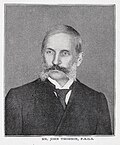File:THE BELL TOWER, PEKING.jpg

Original file (2,951 × 2,639 pixels, file size: 1.65 MB, MIME type: image/jpeg)
| This is a file from the Wikimedia Commons. Information from its description page there is shown below. Commons is a freely licensed media file repository. You can help. |
Summary
| DescriptionTHE BELL TOWER, PEKING.jpg |
English: John Thomson: BELLS appear to have been used in China from the earliest times. It is reported in the Shoo-king, or " Classic Historical Documents," that during the reign of Chung-kang, 2159 B.C., every year, in the first month of spring,[3] " the herald with his wooden-tongued bell goes along the roads proclaiming," and at the present day in China we still meet the counterpart of this ancient prototype striking his bell with its wooden tongue or mallet. We can thus invest the office of town-crier or bell-man, whose occupation in England is now all but gone, with a splendid classic antiquity. During my stay in Peking, accompanied one of our attaches to a shop in « Curiosity Street," where I saw a small bell, reputed to be the most ancient in the empire. It partook to some extent of the modern bell shape, but besides having an inscription in the most antique Chinese characters, it was adorned externally with a series of knobs so arranged that a sort of gamut was produced by striking each in succession with a mallet It is thus possible that the herald of antiquity may have proclaimed the orders of his imperial master in rhyme, and charmed the cars of the people with a harmonious accompaniment on his single bell.
The Bell Tower of the illustration (No. 22) is situated about a quarter of a mile beyond the Hou-Men, or north gate of the capital, and contains one of the five great bells cast when Yung-lo of the Ming dynasty occupied the imperial throne. Each of these bells weighs about fifty-three tons, and its proportions, according to Verbiest, are, width 13 feet, circumference 40 feet, and height 12 feet. One bell is in the palace beside the Tai-ho-tien; another, cast with the entire text of a Buddhist liturgical work on its outer face, now hangs at a temple outside the north-west gate of Peking; a third is here, while a fourth lies half buried in an obscure lane near this tower, and there is a fifth in some other temple. These bells are slightly conical and dome-shaped at the upper end. The fourth one was rejected on account of a flaw, but the others are as perfect examples of the art of casting great masses of metal as we could produce in Europe at the present day, and the like indeed may be said of the astronomical instruments belonging to the same period, and which I have already described. The Tower bell has a rich mellow tone, which can easily be distinguished, when the watches are struck at midnight, all over Peking. |
||||||||||||||||||||
| Date |
before 1898 date QS:P,+1898-00-00T00:00:00Z/7,P1326,+1898-00-00T00:00:00Z/9 |
||||||||||||||||||||
| Source | Beinecke Rare Book & Manuscript Library | ||||||||||||||||||||
| Author |
creator QS:P170,Q736862 |
||||||||||||||||||||
Licensing
| Public domainPublic domainfalsefalse |
|
This work is in the public domain in its country of origin and other countries and areas where the copyright term is the author's life plus 70 years or fewer.
| |
| This file has been identified as being free of known restrictions under copyright law, including all related and neighboring rights. | |
https://creativecommons.org/publicdomain/mark/1.0/PDMCreative Commons Public Domain Mark 1.0falsefalse
File history
Click on a date/time to view the file as it appeared at that time.
| Date/Time | Thumbnail | Dimensions | User | Comment | |
|---|---|---|---|---|---|
| current | 08:43, 25 January 2014 |  | 2,951 × 2,639 (1.65 MB) | 維基小霸王 | User created page with UploadWizard |
File usage
The following 2 pages use this file:
Metadata
This file contains additional information, probably added from the digital camera or scanner used to create or digitize it.
If the file has been modified from its original state, some details may not fully reflect the modified file.
| Width | 11,297 px |
|---|---|
| Height | 8,574 px |
| Bits per component |
|
| Pixel composition | RGB |
| Orientation | Normal |
| Number of components | 3 |
| Horizontal resolution | 72 dpi |
| Vertical resolution | 72 dpi |
| Software used | Adobe Photoshop CS6 (Windows) |
| File change date and time | 20:30, 23 January 2014 |
| Exif version | 2.21 |
| Color space | Uncalibrated |
| Unique ID of original document | 181FBC816B62F13D31680D4EAB403E8A |
| Date and time of digitizing | 18:59, 18 January 2014 |
| Date metadata was last modified | 04:30, 24 January 2014 |
| IIM version | 5,823 |
